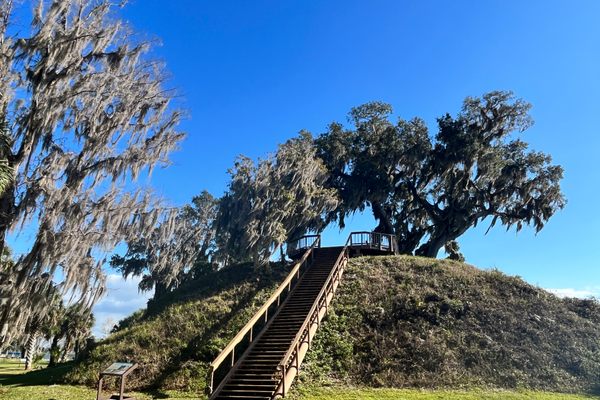
10 Reasons to Explore Citrus County: Forests, Springs, and a Hippo Citizen
Plus endless opportunities for hiking, biking, and paddling through lush nature
Many tourists who visit Florida head for Orange County, home of the state’s most famous theme parks. But just 85 miles west of here lies a lesser-known county, with a similar name and its own wild character. If you’re looking to explore Florida’s natural beauty, or if you’re into hiking, biking, and paddling, you should visit Citrus County. The region is home to forests, springs, trails, and the oldest hippopotamus in captivity.
That hippo is Lucifer, better known as Lu, and he took up residence in what’s now Homosassa Springs State Park back when it was just another roadside attraction. When Florida took over the property, Lu faced a possible eviction: only native animals are allowed in the state parks. Luckily, his many fans beseeched the then-Governor Lawton Chiles for a special dispensation to let Lu stay. In 1991, Chiles declared Luan an official citizen of Florida, and Lu has been delighting (and occasionally splattering) visitors ever since.
But Lu isn’t the only worthy attraction here – there’s plenty more wildlife and incredible nature to see. Use this guide to inspire your next adventure to Citrus County.

See the Sea Cows
1. Hike The Homosassa Springs Wildlife State Park
The Wildlife Walk takes visitors past captive bobcats, red wolves, alligators, flamingos, black bears, and Florida panthers. Panthers are the official Florida state animal, yet they’re also on the endangered species list, so seeing them here is a rare treat.
The park’s most notable landmark is the enormous manatee statue out front, large enough to be seen from the nearby U.S 19. If you’d rather see a living manatee, you’ll find them in the Fish Bowl Underwater Observatory sunk down in the spring itself. Each day at 11 a.m. and 1 p.m, the park has a manatee program in the bleachers that overlooks the Fish Bowl. The 20-minute show offers a quick tutorial by a park volunteer about manatee biology, diet, reproduction, and other basics.
Manatees are central to tourism in Citrus County, thanks to a Cornell University grad student named Daniel “Woodie” Hartman, who conducted the first in-depth study of the lives of manatees in the late 1960s. He ended up writing about his research for National Geographic. Jacques Cousteau happened to read the article, and featured Florida’s “forgotten mermaids” on his popular TV show in 1972. Soon, tourists began pouring in, and Crystal River is now the only community in America with a manatee-based economy.

Don’t Miss the Mounds
2. Stroll the Crystal River Archeological State Park
This 61-acre site just off U.S.19 contains six pre-Columbian burial and temple mounds, demonstrating that this was one of the longest continuously occupied sites in Florida. Not only was it occupied for more than 1,000 years, but the evidence shows people traveled thousands of miles to visit every year to trade goods, celebrate holidays and important events, and bury their dead.
For a stroll through the park, take the mile-long trail and stop by the museum, a piece of memorable ‘60s architecture which shows off some of the artifacts found amid the mounds. The trail includes a 51-step staircase to the top of Temple Mound A, which rewards you with a beautiful view of the surrounding tidal creek.

Local Paradise
3. Paddle into Hunter Springs Park
Described as “the jewel of Crystal River,” and beloved by locals, Hunter Springs Park offers a relaxing stopover at the most accessible spring in Kings Bay. In addition to the boardwalk for manatee viewing, the park is open to swimming year-round and has a playground, picnic area and kayak launch. There’s a fee for the use of the launch but no kayak rental is available at the park. However, kayaks are available for rent from many outfitters out of Kings Bay to ensure you have a wonderful day on the water.

Crystal Clear
4. Hike Crystal River Preserve State Park
To step into Crystal River Preserve State Park is to enter a time machine. Much of the property has remained untouched for centuries, allowing visitors a vision of Florida of the past. The park, just down the road from Crystal River Archeological State Park, stretches 20 miles along the Gulf Coast between Yankeetown and Homosassa, protecting more than 27,000 acres of scrub, pinewoods, hardwood forests, salt marshes and mangrove islands.
There are two kayak and canoe launches – one by the park headquarters, the other by Mullet Hole. Crystal River Preserve Adventures offers reservations for guided kayak excursions, as well as eco-tours on Monday, Wednesday and Friday provided by the 24- seat vessel “Monroe.” But what many visitors prefer is to hike or bike on the Seven-Mile Loop Trail, which is the longest unpaved loop in Citrus County.
What adds even more to its appeal is that it’s part of the Great Florida Birding & Wildlife Trail. The coastal location combined with the undeveloped character of the park makes it a major hotspot for birders looking to boost their life lists.
Be forewarned – there are no restrooms or potable water on the trail, so take your canteen and be sure you go before you go.

Prime Paddling
5. Paddle the Tsala Apopka Lakes
Another prime paddling spot is the Tsala Apopka chain of lakes. This is the largest freshwater system in Citrus County, covering approximately 22,000 acres near Inverness.
Local residents love the undeveloped feel of the area, although people have altered the landscape repeatedly since the 1880s. Now, it’s three separate pools that connect 15 lakes relying on water from groundwater, rainfall, and surface water movement from the Withlacoochee River.

Chain Reaction
6. Bike the trails of Flying Eagle Preserve
The Tsala Apopka Chain of Lakes surrounds most of the Flying Eagle Preserve, which is a mosaic of lakes, marshes, and swamps along five miles of the Withlacoochee River. Along the water are 22 miles of multi-use trails winding through woods and old pastures, making the preserve a terrific place to hike or bike.
The preserve is part of the Great Florida Birding Trail, which means you’re liable to see everything from ducks to wild turkeys to raptors here. Birds recorded in the preserve include sandhill cranes, Eastern screech-owls, brown thrashers, and anhinga, whose long necks have earned them the nickname “snakebirds”. You’re also likely to see gopher tortoises, which Floridians used to call “Hoover chickens” during the depression. Don’t try to eat them now – they’re a protected species.

Rails to Trails
7. Bike Withlacoochee State Trail
An even better ride—if you’re up for it—can be had on the 47-mile Withlacoochee State Trail. The trail passes through three counties (Citrus, Hernando, and Pasco), making it one of the longest paved rails-to-trails projects in the state.
Of course, you don’t have to ride the whole trail all the way to the end in one trip. It passes through several small towns that offer a good place to stop for the afternoon or the night (or even the week).
“The southern end of the trail offers plenty of shade and a nice view of the Withlacoochee River while the northern end is more open,” says trail manager Christopher Raby. “My favorite portion is the mid-section of the trail that runs through downtown Inverness and borders Wallace Brooks (park) and Liberty Park.”

Travel on Foot
8. Walk the Liberty Trail Boardwalk
You can peel off the Withlacoochee State Trail to explore the Liberty Trail, a meandering boardwalk through cypress and palm trees that runs along Lake Henderson and connects Liberty and Wallace Brooks parks.
You’ll have to park your bike and tie your walking shoes, because the Inverness-owned Liberty Trail is for foot traffic only. By slowing down, though, you have a better chance to spot the wildlife all around you. Waterfowl such as egrets and herons swoop in to feed in the marshes, and you’re likely to see alligators and turtles, not to mention occasional water snakes. In other words: no swimming allowed.

Manatee Haven
9. Walk the Boardwalk at Three Sisters Springs
To protect the natural habitat of manatees, the U.S. Fish and Wildlife Service set up the Crystal River National Wildlife Refuge in 1983 which covers Three Sisters Springs, the last unspoiled and undeveloped spring habitat in Kings Bay.
You can view Three Sisters Springs from land by hiking the boardwalk, which offers a variety of viewing platforms and regular guided tours during what the staff calls “manatee season.” Beginning in mid-November, manatees flood Three Sisters, seeking the warmth of the springs’ flow from underground which protects them from the cold. That crowding usually continues until late March, when the temperatures rise and they slowly disperse. Visiting outside of peak sea cow season? Not to worry, it’s still possible to see manatees and your best chance of spotting them is the early mornings.
Other times of the year, stroll the refuge’s nature trails, which provide views of Magnolia Springs, Lake Crystal, and the restored wetlands. Here you can spot up to 100 different native and migratory bird species that have flocked to this lush home.
You can’t jump into the spring from the boardwalk and splash around with the manatees, but you can bring or rent a canoe or kayak and launch from any of the public boat ramps or kayak launches on Kings Bay. Then you can make your way to the spring run for Three Sisters, and see it from the water, just as the manatees do.

Water and Wildlife
10. Paddle Chassahowitzka National Wildlife Refuge
This is it: the one place where everyone says you can experience Florida the way it was meant to be. People will call it “pristine”, or “wild”, or “undeveloped”, but whatever you call it, the Chassahowitzka National Wildlife Refuge will blow your mind.
The refuge, which encompasses more than 31,000 acres, was established in 1943 for the protection of the flocks of migratory birds that stop off there. There’s a visitors center with a two-story observation tower, but most of the refuge is accessible only by water and best experienced from a kayak or canoe along the spring-fed Chassahowitzka River.
In addition to the birds, the mix of saltwater bays, estuaries and brackish marshes provide the perfect environment for a variety of marine life including manatees, which like to graze on the seagrass meadows in the refuge’s tidal bays, creeks and rivers in warmer weather. For them, it’s the ultimate salad bar.
This post is sponsored by Discover Crystal River. Click here to explore more.





























Follow us on Twitter to get the latest on the world's hidden wonders.
Like us on Facebook to get the latest on the world's hidden wonders.
Follow us on Twitter Like us on Facebook